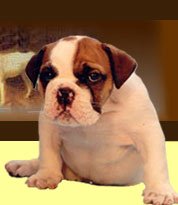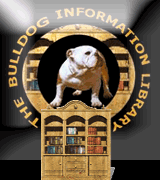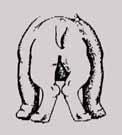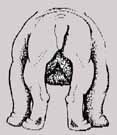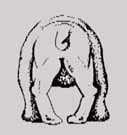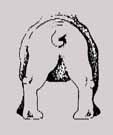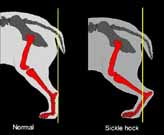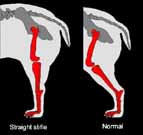The English Bulldog
Breed Standard
(part 4)
.
.
.
detailed and explained by Catherine Marien
Complete with the latest official amendments,
September 2003 (in brown in the text)
hindquarters, feet, tail , gait, coat, colors
Hindquarters
The legs should be large and muscular, and longer in proportion than the forelegs, so as to elevate the loins. The hocks should be slightly bent and well let down, so as to be long and muscular from the loins to the point of the hock. The lower part of the leg should be short, straight and strong. The stifles should be round and turned slightly outwards away from the body. The hocks are thereby made to approach each other, and the hind feet to turn outwards.
Incorrect hindquarters
Pigeon-toed, i.e. hocks
turning out and
toes pointing inwards
Incorrect hindquarters
cow hocked, i.e. hocks
turning in provoking
toeing out of rear feet
Correct hindquarters
The slight turn-out at
the stifle permits the
hocks to approach each
other just a bit.
Hindlegs to wide apart
Body is missing the
"pear shape"
Source: Millennium Bulldog Club of Pretoria
Correct hind legs, the knee
joint (stifle) and the heel
(hock joint) should be slightly
bent and the lower part of
the leg from the hock to the feet
(the pasterns) should be short.
Incorrect hindquarters
Straight stifles, no flexion
of the stifles or hocks,
resulting in a stilted,
unnatural movement.
(compare normal on the left)
Incorrect hindquarters with sickle hocks,
over flexion of the hock joint
(impression of a 'sickle').
The result is an unnatural, 'waterpumping'
action of the hind legs during movement.
(compare normal on the right)
Feet
The hind feet, like the fore feet should be round and compact, with the toes well split up and the knuckles prominent. The fore feet should be straight and turn very slightly outward, of medium size and moderately round. The toes compact and thick, being well split up, making the knuckles prominent and high.
Correct feet
slightly turned-out
Incorrect turned-out feet
The tail, termed the "stern", should be set on low, jut out rather straight, then turn downwards. It should be round, smooth and devoid of fringe or coarse hair.
Screw tail. Allowed by US Standard,
incorrect according to the UK standard,
but rarely penalised in show rings
Faulty tail carried gaily
Gait
From its formation the dog has a peculiar heavy and constrained gait, appearing to walk with short, quick steps on the tips of its toes, its hind-feet not being lifted high, but appearing to skim the ground, and running with the right shoulder rather advanced, similar to the manner of a horse in cantering. Soundness of movement of the upmost importance.
Coat and colour
The coat should be fine in texture, short, close and smooth (hard only from the shortness and closeness, not wiry).
The colour should be whole or smut (that is, a whole colour with a black mask or muzzle). The only colours (which should be brilliant and pure of their sort) are whole colours - viz., brindles, reds, with their varieties, fawns, fallows, etc., white and also pied (i.e., a combination of white with any other of the foregoing colours). Dudley, black and black with tan are extremely undesirable colours.
Weight and Size
The most desirable weight for the Bulldog is 25 kg. (55 lbs) for a dog and 23 kg. (50 lbs) for a bitch.
Note: Male animals should have two apparently normal testicles fully descended into the scrotum.
back to Standard - Head & Skull
It should be moderate in length - rather short then long - thick at the root, and tapering quickly to a fine point. It should have a downward carriage (not having a decided upward curve at the end), and the dog should not be able to raise it over its back.
Original idea, design and development by C. Marien-de Luca. No part of bulldoginformation.com may be copied, distributed, printed or reproduced on another website without the owner's written permission. Please feel free to link from your site to any of the pages on this website in a non-frame presentation only.


